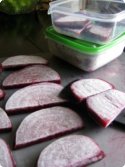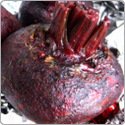|
The Secrets of Good Borscht
Borscht (also borscht, borshch, borsh), a beetroot soup, the classical first course traditional in Slavic countries, is one of the best-known soups that has been made so universally by the people of various countries and is regarded as a national dish, and always thought of as typical of the particular cuisine. Readily adopted and sometimes even claimed as their own by Russians, Poles, Lithuanians, and other nationalities, its strongest relations are with the Ukraine, where it is thought to have originated back in the thirteenth century. According to the etymological dictionaries of the Slavic languages, the word borscht comes from the plant originally called borsch (which means cow parsnip or hogweed), edible leaves of which were used in food. An apparently widespread belief that "brsch” is an Old Slavic name of beets can be classified as folk Etymology. Different soups, sometimes called borscht, can be made with cabbage, tomato or sorrel, to name just a few.The ingredients and methods of preparation vary greatly according to country, city and cooks who prepare them. However, the staple ingredient of borscht is always the luscious red beet that gives the soup its characteristic color and flavor. Classic Ukrainian borscht should include pork or beef, ham, or other meats – the more meat, the better. Try making it with short ribs or port ribs, adding some diced ham or smoked kielbasa at the end. Also important for a good borscht is to prepare the stock and vegetables correctly, strictly observing the proper order in which the ingredients are added. Properly prepared stock is the basis of good borscht. A special feature of the preparation of vegetable borscht is a pre-split processing of vegetables. Beets are always prepared separately from other vegetables, and sometimes sprinkled with vinegar, or citric acid, or lemon juice, to preserve the red color, put in heated fat and sauteed until done.
This might sound like a complicated process, but a Simple Ukrainian Borscht is an easy enough meal to make, and can become a staple in everyday menu as nutritious and comforting food. In other recipes, the beets are baked or boiled until half done, then peeled, cut and placed into the broth. All other vegetables – potatoes, cabbage, carrots, onion, parsley, garlic and spices – are added in strict order depending on their time of cooking. Kvass or juice of sour beets sometimes added to give the borscht a distinctive sour taste. Ukrainian borscht is served hot with a dollop of sour cream, and in the old times constituted a meal in itself for the whole family. It is relatively a time-consuming process – cooking time of the proper borscht can take a minimum of 3 hours, but the reward is more than gratifying. In the heat of summer, we make cold beet soups: Cold beet borscht is a great meal in itself, or a first course for a light summer dinner. For this vegetarian beet borsch all you have to do is cook a lot of beet liquid and then add various vegetables - potatoes, radishes, cucumbers, green onions, etc. – depending on your taste, and what you have on hand. Traditional Lithuanian šaltibaršiai, another recipe for a cold borscht, calls for using kefir (plain buttermilk, or yogurt) as a base. This recipe, as the one above, is not an ideal or precise borscht recipe. Change of proportions and ingredients is allowed and will reflect your taste – mix kefir with water or sour cream to vary consistency of the soup, cook greens along with beets, etc. Feel free to experiment. Refreshingly light summer borsch made with dried mushrooms and green apples, stuffed with crisp and tender textures, is another quick and healthy recipe to try. It can be whipped in less than an hour, and uses simple ingredients that do not require a shopping trip to a gourmet store. Jellied beet soup, an unusual recipe that is fun to make when you feel like surprising your summer party guests with a gourmet meal. Serve it with black caviar on a dollop of sour cream for a vivid contrast against the crimson of beets. Chilled cherry borscht will please you with intense color and a smooth blend of Bing cherry taste and beets. Search Healthy Beets:  Custom Search |








